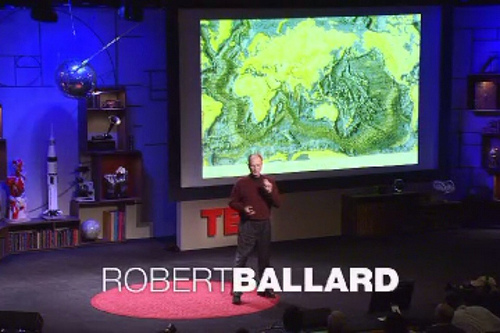Robert Ballard on exploring the oceans | Video on TED.com

プレゼンターのRobert Ballard氏は海洋学者です。
On more than 120 deep-sea expeditions, Robert Ballard has made many major natural discoveries, such as the deep-sea vents. Oh, and he found the Titanic.
とありますように120を超える深海の探索をされてきています。タイタニック号を見つけられたことでも有名な方です。プレゼンの最初から最後まで言葉が口から溢れるが如く、スピードの速い英語で話されるのでシャドウイング上級者の方にぴったりなプレゼンです。
I'm going to take you on a 16 minute trip on 72 percent of the planet, so buckle up.
OK. And what we're going to do, is we're going to immerse ourselves in my world.
buckle up は“シートベルトを締める” が原義ですが、ここでは私の話に気合入れてついてきてくださいよというオーディエンスに対する合図ですね。
プレゼンはBallard氏のこういう問いかけからはじまります。
Why are people afraid of the ocean? Or do they just assume the ocean is just a dark, gloomy place that has nothing to offer?
そう思うのはこの私のプレゼンを聴いてからにしてくださいよと云わんばかりのBallard 氏の熱いプレゼンの始まりです。
18分フルのプレゼンで、しかもBallard 氏の高速英語もプラスされかなりの情報量です。なので印象深いシーンだけをpick up していきたいと思います。
まずは海洋探査で面白いと思ったのがBallard 氏の次の言葉です。
~ mostly discoveries made by accident. We were looking for something and found something else.
何かを探しに出かけたらそれとは違う別の何かを発見するんだよとあります。人生といっしょですね。偶然の中の必然みたいな。
50 percent of the United States of America lies beneath the sea. 50 percent of our country that we own, have all legal jurisdiction, have all rights to do whatever we want, lies beneath the sea and we have better maps of Mars than that 50 percent. Why?
法的に何だって自由にできる国土が半分も海の中にあるというのに、それは手つかずのまま放置され、それよりも遠い火星の方が、海底より詳しい地図があるなんてどういうことやねんとBallard 氏はここでも少々テンション高めです。
昔はこういう形のsubmarine (潜水艦)に乗って海底まで潜って行ったそうです。
~in the summer of 1973/1974 and were the first human beings to enter the Great Rift Valley.
Great Rift Valley とはアフリカ大陸・東部を南北に走る大地溝帯です。
下1行目のthisは⬆このスライドのことです。
Ballard氏が潜水艦にのって海底探索中のイラストですね。
海底の全く以て正確な(all accurate)様子です。真っ暗だということを除けば(except for)ねと。
We went down into the Rift Valley,this is all accurate except for one thing -- it's pitch black. It's absolutely pitch black because photons cannot reach the average depth of the ocean, which is 12,000 feet.
photon はロングマンによると
a unit of energy that carries light and has zero mass
となっています。これがないので周りはpitch black(漆黒)というわけですね。
そしてBallard 氏達のチームはこの真っ暗闇の中に存在する火山の調査を開始され
ます。なんと海底には
There are more active volcanoes beneath the sea than on land by two orders of magnitude. So it's a phenomenally active region, it's not just a dark boring place. It's a very alive place. And it's then being ripped open.
海底の方が地上より二桁も活火山が多いなんて知りませんでした。
なんか深海に対して持っていた暗~くて、物寂し~いイメージが吹き飛びます。
この後は海底探査でBallard氏が発見された様々なものを次から次から紹介してくれます。う~ん贅沢!
What you're looking at is an incredible pipe organ of chemicals coming out of the ocean.
Everything you see in this picture is commercial grade -- copper, lead, silver, zinc and gold.
海底から吹出すcopper(銅), lead(鉛), silver(銀), zinc(亜鉛) and gold(金)などをなんともビジュアル英語で表現されています。ほんとまさに大聖堂のパイプオルガンのようです。
この漆黒の世界で生き物も発見されています。
下の気持ち悪い生き物はチューブワーム。
We discovered a profusion of life in a world that it should not exist. Giant tube worms, 10 feet tall.
I remember having to use vodka -- my own vodka -- to pickle it because we don't carry formaldehyde.
10フィートといえば約3メートルじゃないですか。デカすぎ。
ウォッカをホルマリンの代わりに使わって持ち帰ったんですね。
下のスライドは海底に広がる巨大貝の大群です。真っ白です。
We went and found these incredible clam beds sitting on the barren rock -- large clams,
この貝をパカっと開けたのが下のスライド。
~when we opened them they didn't look like a clam.
And when we cut them open they didn't have the anatomy of a clam. No mouth, no gut, no digestive system.
mouth(口)、gut(内蔵)、それにdigestive system(消化器官)
すらない貝です。
Their bodies had been totally taken over by another organism, a bacterium, that had figured out how to replicate photosynthesis in the dark through a process we now call chemosynthesis.
化学合成とよばれるプロセスを通して、暗闇のなかでの光合成をやってのけたスーパー?バクテリアに貝の体がtake over(のっとり)されちゃったわけですね。
こういった漆黒の海底にたどり着くまではとにかく時間がかかります。
Average depth of the ocean 12,000 feet, two and half
hours to get to work in the morning. Two and half hours to get to home. Five hour commute to work. Three hours of bottom time, average distance traveled -- one mile.
通勤に5時間かかるのに、海底に入れる時間はたった3時間。
こんなめんどくさい事もうやってられないということで、Ballard氏は新たな海底探査のテクノロジーを導入されます。
So I began designing a new technology of telepresence using robotic systems to replicate myself, so I wouldn't have to cycle my vehicle system
ロボットを使って海底での作業を遠く離れたところから行うtelepresenceテクノロジーです。海底にBallard氏の分身を作り出すことによって探査の効率性がさらにスピードアップしていきます。
~they discovered edifices down there that they did not understand.That did not make sense. They were not above a magma chamber.
They shouldn't be there. And we called it Lost City.
こんな不思議な建物まで見つかっています。
edificeはロングマンによると
“a building, especially a large one”
となっています。
まるで海底神殿のようです。
そしてこれもby accident(偶然)に見つかったhydrothermal vent systems(熱水排水口)だそうです。
確かに海の底はグツグツと躍動感にあふれた成果であることがよくわかります。
さー次は映画などでもなじみのある沈没船の数々。ほぼ原型をとどめたまま沈んでいます。
上のスライドのような船や下のスライドのような工芸品が海底に陳列されているがのごとく沈んでいる様子をBallard氏は次のように表現されています。
The realization that the deep sea is the largest museum on earth.
It contains more history than all of the museums on land combined.
地球上に存在する中で最大規模の博物館だと。
Ballard氏は毎日、毎日こんな世界で仕事をされていたら1日なんてあっという間に過ぎ去ってしまうでしょうね。
You still see the bees wax dripping. When they dropped they sealed it. This ship sank 1,500 years ago.
1500年前に沈んだ船の中にあった壺から蜜蝋が滴り落ちてきています。すごい!
Ballard氏はロビー活動もされていて下の船はアメリカの海軍から調達したのだそうです。
この船で何を探しに行くのか?
The way we're going to run this we have no idea what we're going to discover. We have no idea what we're going to discover. We're going to discover an ancient shipwreck, a Phoenician off Brazil, or a new rock formation, a new life. So we're going to run it like an emergency hospital.
なんかいいですね。この自由な感じが。Ballard氏のわくわくされている感じがvividに伝わってきます。
ここの英語表現も絵になるな~。どんな急患(海の底に眠る様々なお宝)が運ばれてくるかわかんないから、救急病院みたいに(like an emergency hospital)運営していくんだとおっしゃっています。
さらに沖合いに出かけていく船から降ろされる探索ロボットを遠隔操作し、様々な情報を処理していく下のスライドのような建物も建築予定だそうです。ここで集められた情報はアメリカ国内の主要な大学に配信されていきます。
そして実はここからが私がRobert Ballard氏のプレゼンで一番感動したところなのです。もしこの後のシーンがなければこのプレゼンをご紹介しようとは思いませんでした。
Ballard氏には海洋学者としての顔のほかに、もう一つ教育者としての顔があります。TEDのバイオグラフィ欄に下の記述があります。
He's also a powerful storyteller and a passionate scientific educator. He founded the Institute for Exploration and has pioneered distance learning in classrooms around the world. Through his JASON Project, 1.7 million students a year join scientists virtually as they experience the thrill of exploration and discovery.
日本でも大学入試予備校などでおなじみの衛生配信の授業がありますが、Ballard氏はそれを世界規模で行われています。
海底探査の素晴らしい世界を専門家が独占するのではなく、それを共有していこうと、Ballard氏の分身とも言うべきロボットを操るのがなんと、下のスライドにあるように子供たちなのです。その理由は
I would not let an adult drive my robot. You don't have enough gaming experience. But I will let a kid with no license take over control of my vehicle system.
would not~ “絶対に~させない”
十分なゲーム経験のない大人には、私のロボットの操作はまかせない。代わりに運転免許を持たない子供たちに自分のロボットシステムを操作してもらうんだと。
Because we want to create. We want to create the classroom of tomorrow. We have stiff competition and we need to motivate and it's all being done.
未来の教室を創造したいんだと。熾烈な競争に打ち勝っていくに足る動機付けを子供たちに与えてあげなけれないけないなだということですね。
中学生の時に海洋探査の最前線に立つBallard氏のロボットシステムを操作するという経験を実際にした子供たちは、自分も将来、科学者や研究者になって未知の分野を切り開いていくんだという強烈な原体験をするはずです。
その経験というのは、一握りの人しかなれないであろう研究者や科学者への道に進んでいく際に待ち受けている様々な困難にぶつかった時に、必ずや支えとなってくれるんだと思います。
そして下のスライドの女の子です。何を見ているのでしょうか?
This is a young lady, not watching a football game, not watching a basketball game.
Watching exploration live from thousands of miles away, and it's just dawning on her what she's seeing.
dawn on~ “~に理解されはじめる”
何千マイルも離れた海底から送らてくるライブ映像を見ているところですね。そして自分の目に入ってきている映像が何なのかが分かりかけているところなんだとBallard氏はおっしゃっています。
And when you get a jaw drop you can inform. You can put so much information into that mind, it's in full recept mode.
この言葉にオーディエンスからも拍手が起こっていました。もうまさにそう、そうと私自身何度もうなずいてしまいます。
脳が完全な受信モードに入ったときの人間の顔をこのスライドの少女は見せてくれています。自分が今見ている世界が何なのかを脳が一切の外部情報を遮断して解析しているところなんでしょうね。
年を経るにつれていろいろな雑念が増え、なかなかそういうモードに入りにくくなっていきます。
毎日何かしら“jaw-dropping”な瞬間というものを追い求めていかないとあかんな~と思わせてくれたRobert Ballard氏のプレゼンでした。
全スクリプトはこちら


























